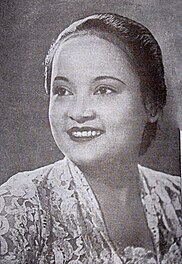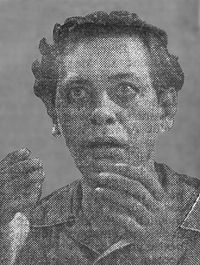
Abisin Abbas, better known by his pseudonym Andjar Asmara, was a dramatist and filmmaker active in the cinema of the Dutch East Indies. Born in Alahan Panjang, West Sumatra, he first worked as a reporter in Batavia. He became a writer for the Padangsche Opera in Padang, where he developed a new, dialogue-centric style, which later spread throughout the region. After returning to Batavia in 1929, he spent over a year as a theatre and film critic. In 1930 he joined the Dardanella touring troupe as a writer. He went to India in an unsuccessful bid to film his stage play Dr Samsi.

Ratna Asmara, also known as Ratna Suska, was an Indonesian actress and director. Originally active in theatre, she starred in the romance film Kartinah (1940), which her first husband Andjar directed.
Melati van Agam is a 1931 romance film directed by Lie Tek Swie and produced by Tan's Film. Starring A. Rachman, Neng Titi, Oemar, and Bachtiar Effendi, the two-part film follows the young lovers Norma and Idrus. The film, which may be lost, was reportedly a commercial success, but critical reviews were less favourable.

Bachtiar Effendi was an Indonesian film actor and director who also served as a cultural critic. Beginning his film career in 1930, he made several works for Tan's Film before joining a drama troupe.
![<i>Rentjong Atjeh</i> 1940 [[Dutch East Indies]] film](https://upload.wikimedia.org/wikipedia/commons/thumb/b/b4/Rentjong_Atjeh_ad%2C_Star_Magazine_2.20_%28August_1940%29%2C_p50.jpg/320px-Rentjong_Atjeh_ad%2C_Star_Magazine_2.20_%28August_1940%29%2C_p50.jpg)
Rentjong Atjeh is a 1940 action film from the Dutch East Indies directed by The Teng Chun. Telling of a group who take revenge against pirates in the Strait of Malacca, it starred Ferry Kock, Dewi Mada, Bissoe, Mohammad Mochtar, and Hadidjah. It was filmed near the shore in Batavia and reused footage from The's earlier work Alang-Alang (1939). Rentjong Atjeh, inspired in part by the Tarzan films, was a commercial success, although it may now be lost.

Raden Ariffien, or better known as Rd. Ariffien, was an Indonesian film director. Originally a nationalist figure, he entered the film industry in 1940 after working in theater and radio. Throughout his 25 year career, he was involved in some 36 films in various positions. He later became editor-in-chief of the film magazine Varia.

Raden Inoe Perbatasari was an Indonesian politician turned film director and actor.

Roestam Sutan Palindih was an Indonesian film director and writer. He was born in Fort de Kock, Dutch East Indies in 1898. He finished his education in various cities, including Batavia, Bandung, Padang, and Medan. In the 1920s and 30s Rustam held a variety of jobs, including as the owner of a small shop and a farmer. He eventually became involved with the journalistic and literary industries, working at Balai Pustaka and heading the newspaper Neratja. From 1933 until 1938 he was a member of a native political council, vocally opposing the Dutch colonial presence in the Indies.
Tjitra is a 1949 Indonesian film directed by Usmar Ismail for the Dutch-owned production house South Pacific. Starring Raden Sukarno, Nila Djuwita, and Raden Ismail, it follows a man named Harsono who takes a woman's virginity then flees to the city, where he is caught up in a murder case. Ismail's directorial debut, Tjitra was made while its director was still a member of the Indonesian Army. He later disavowed the film, as he felt he had had too little creative input.

Gadis Desa is a 1949 comedy from what is now Indonesia written and directed by Andjar Asmara. Starring Basuki Djaelani, Ratna Ruthinah, Ali Joego, and Djauhari Effendi, it follows the romantic hijinks of a village girl who is taken to be a rich man's second wife. The film, produced by a Dutch-run company, is recognised as the first in which future "father of Indonesian film" Usmar Ismail was involved.

Darah dan Doa is a 1950 Indonesian war film directed and produced by Usmar Ismail, telling the story of the Siliwangi Division and its leader Captain Sudarto on a march to West Java. Following Ismail's Dutch-produced Tjitra (1949), Darah dan Doa is often cited as the first 'Indonesian' film, and the film's first day of shooting – 30 March – is celebrated in Indonesia as National Film Day.

Astaman also known as Tirtosari, was an Indonesian actor active from the 1910s until the mid-1970s. He was a leading actor in the influential theatre company Dardanella and, after entering the film industry with 1940s Kartinah, acted in 43 films.

Ratna Moetoe Manikam, also known by the title Djoela Djoeli Bintang Tiga, is a film from the Dutch East Indies.
Noesa Penida is a 1941 film from the Dutch East Indies which was directed by Andjar Asmara and produced by The Teng Chun of Java Industrial Film. It tells of a love triangle between two brothers, born to a commoner, and a noble woman.
Elang Darat is a 1941 film from the Dutch East Indies which was directed by Inoe Perbatasari and produced by The Teng Chun for Jacatra Film. A detective film, it follows a man who comes to a village to track the villainous bandit known only as "Elang Darat".
Njai Dasima is a 1932 film from the Dutch East Indies which was directed by Bachtiar Effendi for Tan's Film. It was the second film adapted from G. Francis' 1896 novel Tjerita Njai Dasima, following a silent version in 1929. Starring Momo and Oesman, it followed a young Sundanese njai (concubine) who is tricked into marrying a man who does not love her and ultimately killed for her money. The film, the first talkie produced by its company, was also the first directed by a native Indonesian. The now-lost work received mixed critical reception.

Air Mata Mengalir di Tjitarum is a 1948 film from what is now Indonesia, written and directed by Roestam Sutan Palindih for the Tan & Wong Bros Film Company.

Ali Joego was a stage and film actor and director active in the Dutch East Indies and Indonesia. During his twenty-year career he appeared in thirty films and directed seven.

The South Pacific Film Corporation (SPFC) was a Dutch government sponsored feature film producer in the Dutch West Indies. A separate unit produced newsreels in Indonesia. The production company was sponsored under the Netherlands Indies Civil Administration. It was preceded by the Netherlands Indies Government Information Service.







![<i>Rentjong Atjeh</i> 1940 [[Dutch East Indies]] film](https://upload.wikimedia.org/wikipedia/commons/thumb/b/b4/Rentjong_Atjeh_ad%2C_Star_Magazine_2.20_%28August_1940%29%2C_p50.jpg/320px-Rentjong_Atjeh_ad%2C_Star_Magazine_2.20_%28August_1940%29%2C_p50.jpg)









